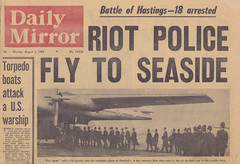 |
| Battle of the Mods & Rockers. Hastings 1964. (Photo credit: Phil Sellens) |
The Mods, with their sharp Italian suits and parkas, contrasted totally with the leather-coated and long-haired rockers.
The mods regarded the rockers as old-fashioned, grubby and oafish, while the rockers regarded the mods as being effeminate, snobbish and weedy.
There is a clear contrast between the metropolitan and the rural shades of Britain which the mod/rocker dichotomy illustrates.
The musical tastes differed markedly too. Mods favored Jazz, Reggae and Soul while the rockers revered the giants of the rock n' roll era such as Elvis Presley and Eddie Cochran.
Throughout the early 1960s, mods and rockers would engage in brawls in many of Britain's seaside towns, particularly along the South coast. Towns such as Margate, Bournemouth, Brighton and Clacton were the scene of much gang-warfare at this time.
In 1964, news-stories appeared which gave the impression of a full-scale war between the two tribes. The media's role in the conflict was central from the outset.
Consequently the mod/rocker war became a subject of interest for the sociologists, psychologists and other society-pundits.
Some saw the conflict as typical male-youth behavior while others regarded it as a new phenomenon; this being relevant when we consider that the growth of technology and the economy had now made possible mass-ownership of scooters and bikes.
The mod scene had been noted for its sophistication and fashion-savvy; it now found itself somewhat unfairly recast as the tribe for deviants and hooligans.
Battles between the two often occurred where territories overlapped, or where rival factions happened on one another. As noted, there was an urban-rural split, meaning that the groups could only fight if brought together by some co-incidence.
Most often, such a scenario would involve an encounter at one of the seaside towns; the getaway destination of choice for British youth in an era before mass air-travel.
In these battles, mods would often be armed with fish-hooks and razors which they had sewn into their jacket-lapels to shred the fingers of an assailant. This was a common tactic of the Teddy Boy gangs of the late 1950s.
Weapons were used by both sides of course, including flick-knives, coshes and bike-chains. The various brawls and conflicts escalated throughout the early 1960s, culminating in Clacton in 1964 during the Easter weekend.
The second round of the violence that began in Clacton occurred a month later during the Whitsun weekend break, when large numbers of rocker and mod gangs descended on Margate, Brighton and Broadstairs, each side unaware they had decided on the same rallying destination.
The rival gangs were openly fighting, often tearing up deckchairs or whatever breakable objects came to hand. Brighton saw the worst of the violence, which raged for two days before moving on to Hastings.
It then spilled back into Brighton where one group of rockers had become trapped on the beach there. Despite attempts by the police to protect them, they were assaulted by gangs of mods.
The newspapers lapped it up, describing the battles as being of "disastrous proportions". The mods and rockers were labeled as "sawdust caesars" and "louts".
Many newspaper editorials fanned the flames of hysteria, with the Birmingham Post in 1964 warning that the mods and rockers were "internal enemies" in the UK. If unchallenged, it went on, they (the mods and rockers) would "bring about the disintegration of a nation's character".
The magazine Police Review argued that the mods and rockers purported lack of respect for law and order would cause violence to "surge and flame like a forest fire".
Some sociologists argued that as media-hysteria about knife-wielding violent mods increased, the image of the fur-collared parka and scooter was bound to provoke punitive reactions among the public.
As a result of the media-coverage, two British MPs visited the seaside areas to survey the damage. This lead to MP Harold Gurden calling for a resolution of intensified measures to control hooliganism.
Prosecutors in the trial of some of those arrested during the fighting in Clacton had argued that neither faction had "serious views" and lacked respect for law and order.
However, there was some suspicion that the media had in some cases used false photographs, interviews and fictional characters to get mileage from the events, many proving unrelated to the mod/rocker issue.
When the media had exhausted real news items, they would publish deceptive headlines with loaded sub-headers such as 'Violence'; often above a report which contained no description of violence at all.
This constant branding by free-association to all things violent and criminal, saw the mods and rockers linked with any critical social issue of the day, such as teen-age pregnancy, drug-abuse and violence.
In this light, the events of Brighton in 1964 can be seen as being a huge media-hype of a situation that had not been planned for, in marked contrast to what was implied by the stream of press-reports at the time.
Its effect was to tarnish the mod image of sophisticated cool with an altogether more sinister aspect; totally distracting from the enormously significant impact that the mod-scene had on British pop and fashion culture; enriching it and paving the way for a more diverse and multicultural society.
The author operates an online clothing shop that specialises in mod t shirts. We stock a large selection of designs including scooter and mod target roundel t shirts.
Article Source: http://EzineArticles.com/?expert=Andy_J_Wilson
http://EzineArticles.com/?Mods-Versus-Rockers:-Brighton,-1964&id=7725967

No comments:
Post a Comment